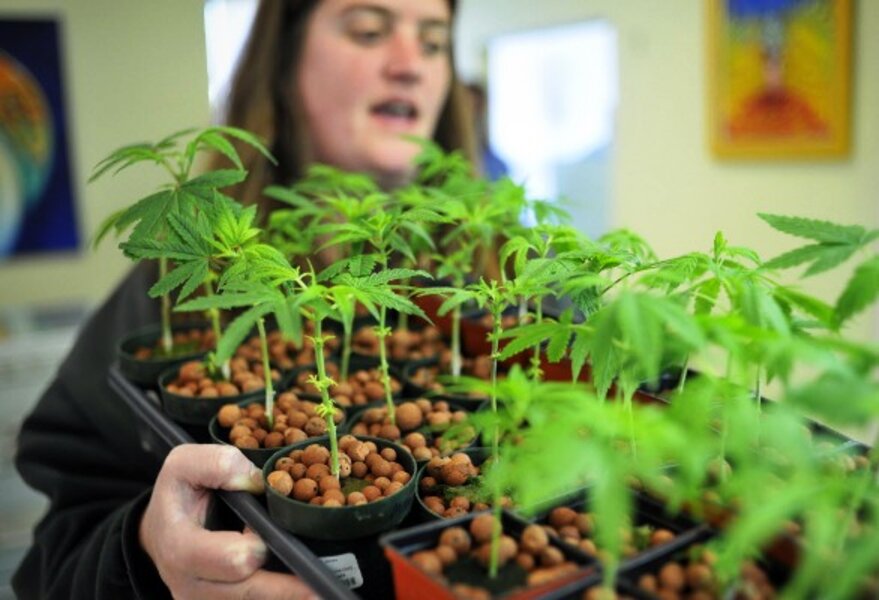Marijuana in the classroom? Sometimes it's legal
Loading...
A high school student found to have marijuana in the classroom would seem to be a prime candidate for a little “talk” with the vice principal – and maybe a trip to the police station.
But around the country today, hundreds – perhaps thousands – of high schoolers are bringing pot to school, and they’re doing it legally. Not to get stoned, but as part of prescribed medical treatment. And they don’t have to tell school authorities about it.
This is putting teachers and principals in a new and challenging position. In many counties and school districts, there are no clear guidelines – for school officials, students, or parents.
“This is all just kind of starting to happen,” high school principal Jeff Schlecht told the Ashland Daily Tidings in Oregon. “It does place us in an awkward position.”
For many students, the issue comes as no surprise.
“I’ve known about this for four years,” Ashland senior Wesley Davis, 17, told the newspaper. “Some of them have it for medical reasons, but others are just trying to get free weed and sell it, turn it around.”
Ritalin used as a recreational drug too
A similar problem has been reported with the prescription drug Ritalin, a stimulant used to treat Attention-deficit hyperactivity disorder (ADHD) – mostly among boys and young men. But as a recreational drug, Ritalin is known as “Vitamin R” or “R-Ball” – used to stay awake at exam time, to help lose weight, or together with alcohol and other drugs to prolong partying. It can produce effects similar to cocaine and amphetamines.
A study cited by the US Department of Education showed that of 6,000 high school students surveyed in Massachusetts, 13 percent were found to have abused Ritalin. The same study found that 4 percent of middle school students had also abused Ritalin.
The issue is very likely to spread around the country.
Earlier this month, New Jersey became the 14th state to legalize medical marijuana. And whereas the Bush administration had operated under the presumption that federal antidrug laws trumped state medical marijuana statutes, the Obama administration has reversed that position.
"It will not be a priority to use federal resources to prosecute patients with serious illnesses or their caregivers who are complying with state laws on medical marijuana," Attorney General Eric Holder said last October. "But we will not tolerate drug traffickers who hide behind claims of compliance with state law to mask activities that are clearly illegal."
Meanwhile, the California Supreme Court on Thursday rejected limits on medical marijuana imposed by state lawmakers, finding that people with prescriptions for pot can have and grow all they need for personal use.
Marijuana used to treat ADHD
At the same time, doctors have become more inclined to prescribe marijuana (as an alternative to Ritalin) for children diagnosed with ADHD.
It’s a controversial trend among medical practitioners.
“It’s safer than aspirin,” Dr. Jean Talleyrand told the New York Times. Dr. Talleyrand is a marijuana advocate who founded a network of 20 clinics in Oakland, Calif. which dispense medical marijuana – including to teenagers diagnosed with ADHD.
But Stephen Hinshaw, the chairman of the psychology department at the University of California, Berkeley, calls it “one of the worst ideas of all time.”
He cites studies showing that the active ingredient in cannabis disrupts attention, memory and concentration – already issues for people diagnosed with attention-deficit disorder.
In addition to being at the forefront of medical marijuana law, California now is considering legalizing and regulating the general use of marijuana.
A proposed bill would remove marijuana and derivatives from existing statutes defining them as controlled substances and make it legal to possess, sell, and cultivate marijuana by those 21 and older, reports the Monitor’s Daniel B. Wood. It sets up wholesale and retail sales regulation with special fees to fund drug abuse prevention programs. And it bans local and state assistance “in enforcing inconsistent federal and other laws.”
A recent poll in California shows overwhelming public support for the idea.
-----
Follow us on Twitter.





